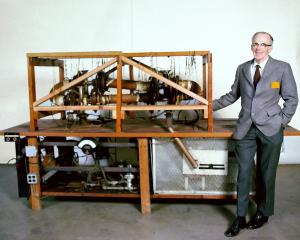Plasma: a strange state of matter
The least well-known state of matter is, paradoxically, also the most prevalent: 99.99% of the visible Universe, including stars and intergalactic matter, is in a state of plasma. Even within our solar system, home to four solid planets (including ours, covered in water) and four gaseous giants, plasma accounts for nearly all matter. Our Sun alone — an enormous sphere of burning plasma — concentrates 99.85% of our solar system's mass.

Whereas in a solid, a liquid or a gas the nuclei of atoms and electrons are closely associated, in a plasma (the fourth state of matter) electrons get stripped from their atoms under the effect of temperature. This "dissociation" creates an ionized gas with radically different properties.
Last century, as the first attempts were made to reproduce the physical reactions taking place in the Sun and stars and to capture — if possible — the prodigious energy released, two plasma properties turned out to be of particular importance: electrical conductivity and sensitivity to magnetic field. Unlike a gas, a plasma is an excellent electrical conductor — one that can be confined and shaped by magnetic field.
In the early 1950s, astrophysicist Lyman Spitzer (1914-1997) was the first to understand the potential of these unique characteristics. By heating hydrogen plasma to very high temperatures and confining it within a magnetic field, the conditions for fusion — the nuclear energy that inundates the Universe with light and energy — could be created. He built his innovative fusion device at Princeton University (USA) in 1951 and called it a "stellarator," in reference to the machine's cosmic inspiration.
With that watershed event, many were convinced that the mastery of fusion was only a few steps away. But scientists hadn't discovered yet how difficult fusion plasmas would be to tame. Stochastic, unstable, fickle and unpredictable ... a plasma's energy or confinement dissipates in a fraction of an instant.
As it became clear how little was really known about this strange state of matter, a new field of scientific exploration — plasma physics — was born. Three generations of plasma physicists have worked at understanding the dynamics of plasmas, unravelling their secrets and bringing order to what is by nature chaotic.
In parallel to this fundamental research, scientists in the United States, France, Great Britain, the Soviet Union, Germany, and Japan were creating new kinds of "fusion machines" (magnetic mirror, theta-pinch, field-reversed configuration...). Although their performance turned out to be disappointing, the potential of fusion seemed too great to give up trying.
In the early 1960s, a remarkable new type of machine made its entry onto the scene. Conceived by Soviet researchers, the "tokamak" (for "toroidal chamber with magnetic coils") produced unheard-of experimental results. At the Kurchatov Institute in Moscow, researchers were able to bring plasma temperatures on the T-3 tokamak near 10 million °C and — what was even more significant for a plasma physicist — surpass 10 milliseconds of energy confinement time, fully ten times what had been achieved in any other device.
The machines that followed — hundreds of tokamaks built the world over with steadily increasing performance — would fulfil the early promise of the T-3 machine. Tokamaks today routinely produce plasmas in the hundreds of millions of degrees and in ITER, the largest tokamak ever built, energy confinement time will be on the order of several seconds ... enough for fusion reactions to be initiated and for them to liberate their formidable quantities of energy.
Plasmas, for their part, continue to preserve a part of their mystery. But physicists have learned to cope. In contemporary tokamaks, plasmas are "dompted" by sophisticated magnetic systems and scientists now know how to anticipate, channel and mitigate their sudden changes of humour.
More than 60 years have passed since Spitzer's brilliant intuition. In ITER, for the first time, humanity will command the fire of the stars.



